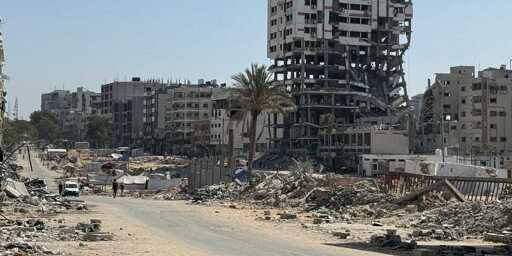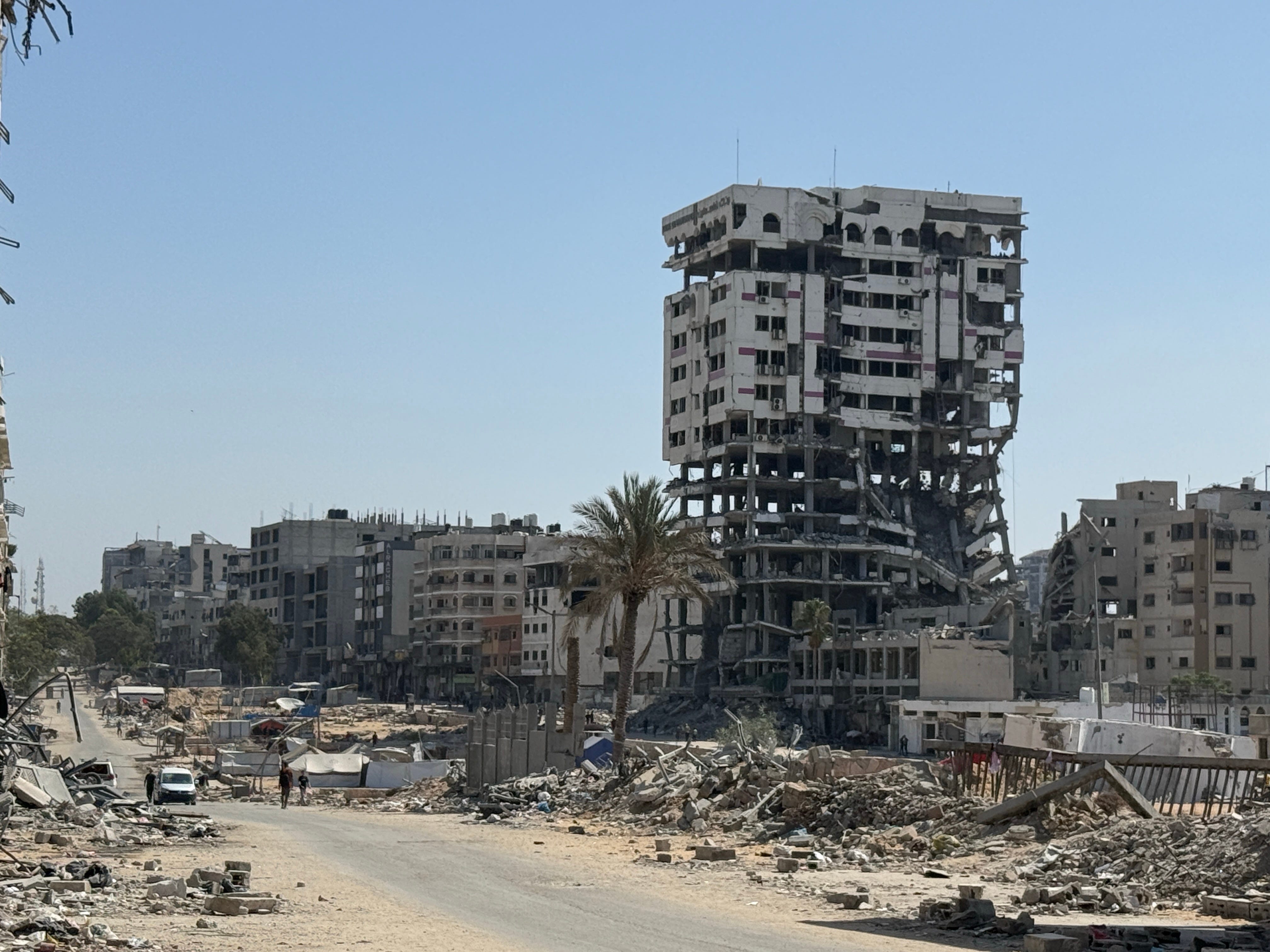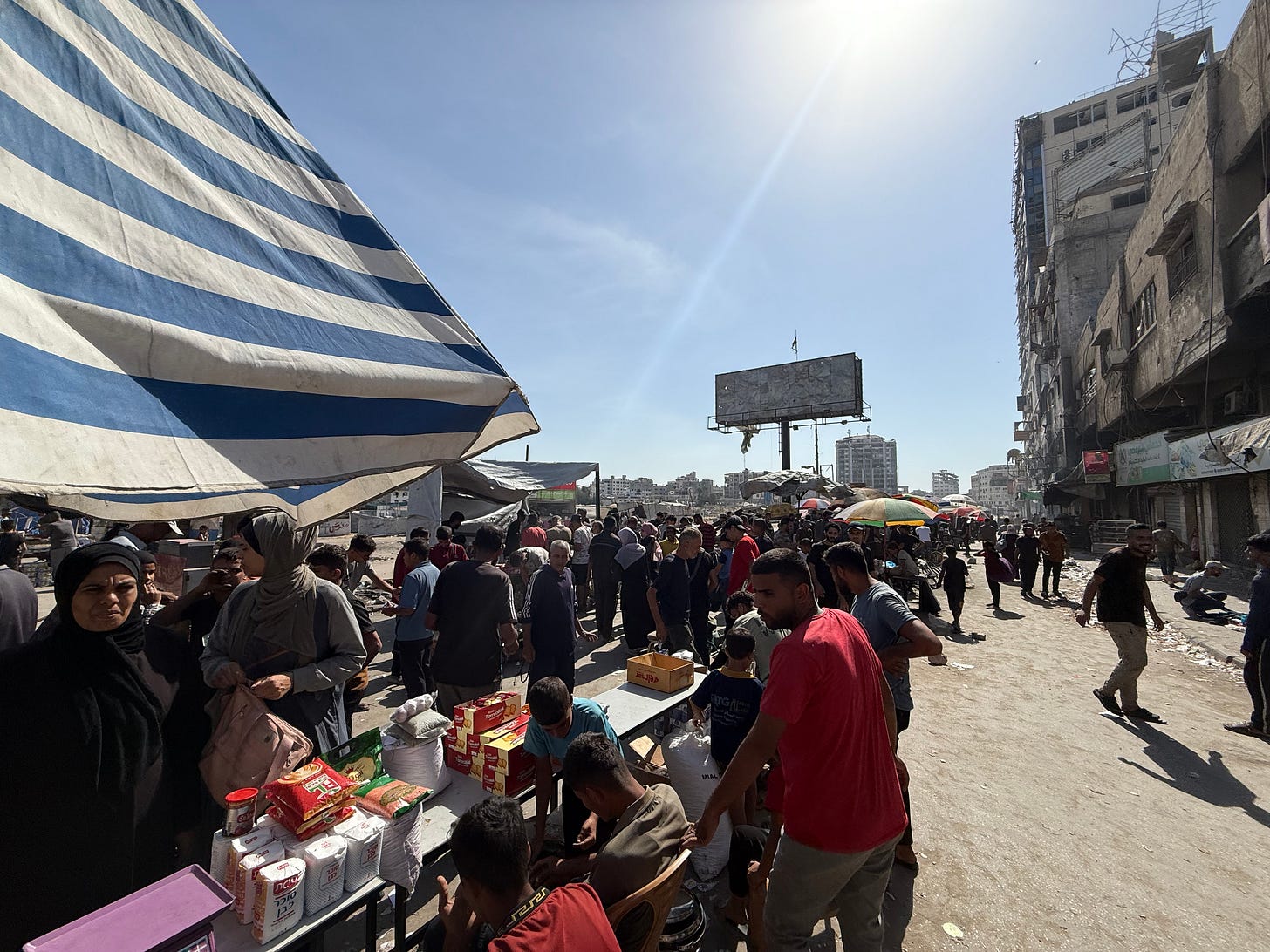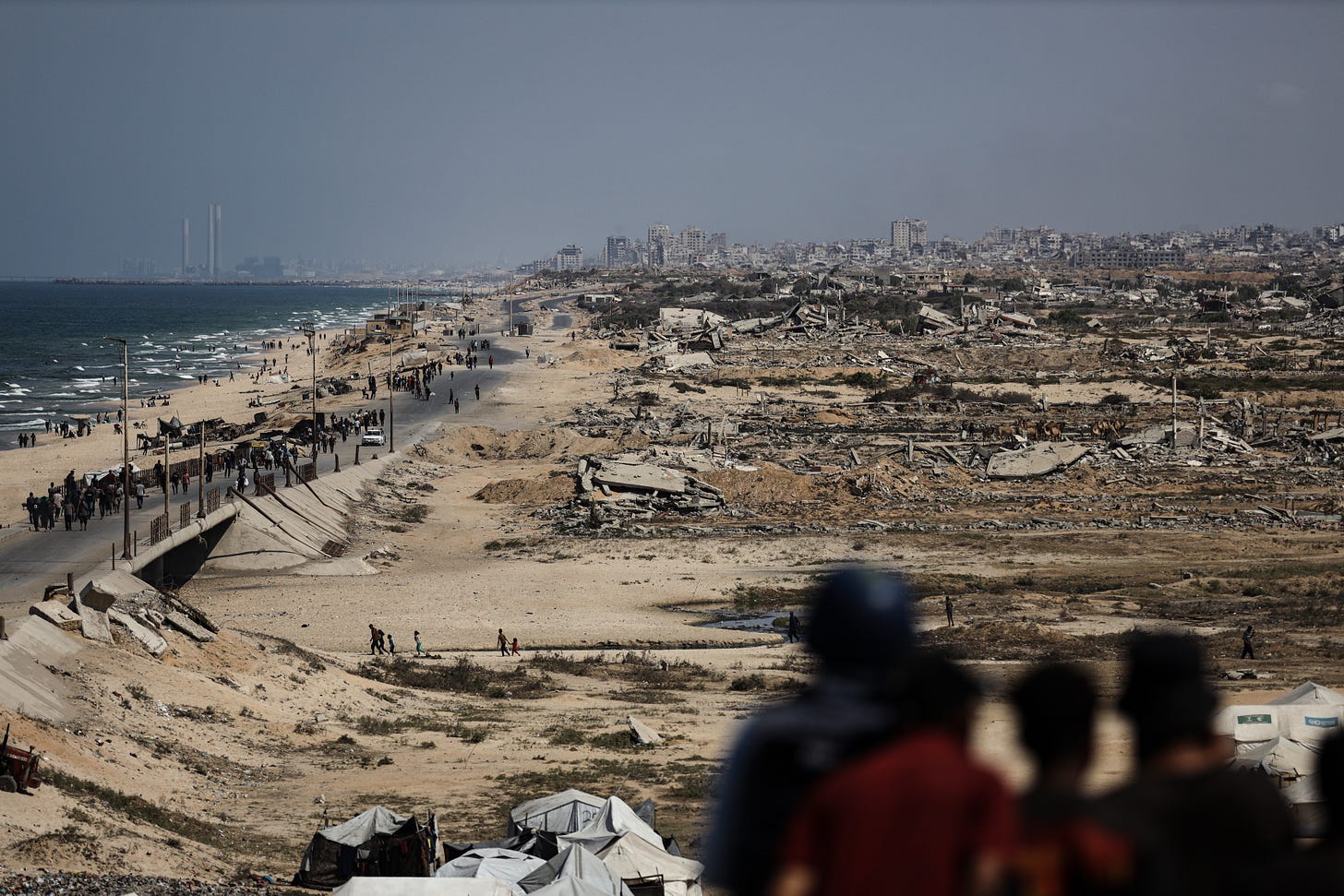We have a commitment to ensuring that our journalism is not locked behind a paywall. But the only way we can sustain this is through the voluntary support of our community of readers. If you are a free subscriber and you support our work, please consider upgrading to a paid subscription or gifting one to a friend or family member. You can also make a 501©(3) tax-deductible donation to support our work. If you do not have the means to support our work financially, you can do your part by sharing our work on social media and by forwarding this email to your network of contacts.
Al-Rimal neighborhood in Gaza City on October 4, 2025. (Photo credit: Khamis Al-Rifi.)
GAZA CITY—Gaza City is a ghost town. Darkness, smoke, and shadows hang over it, illuminated only by the red glow of explosions. The city resembles scenes from apocalyptic films—stories of the end of the world, of human catastrophe, of global wars. Homes stand deserted, streets are emptied, and death encircles us from every direction.
Every morning, new leaflets fall from the sky like snow, ordering us to leave Gaza City and head south. Most residents ignore the leaflets. Some children collect them—not to read but to burn as fuel for cooking; to boil what little rice or lentils they may have. The irony is unbearable: the same papers that demand our departure now keep our small fires alive.
Every day, survival is more difficult, heavier. Basic tasks are insurmountable struggles. Prices keep rising and there’s hardly anything to buy. The waves of displacement that once filled the roads have slowed to a trickle.
To fetch water, you have to walk long distances carrying heavy jerrycans, risking tank shelling and bullets from quadcopters along the way. Wood for cooking is unaffordable since 1 kg (about 2.2 lbs) costs around $2, which is only sufficient to warm up a kettle of tea.
Good food is so difficult to find, and it’s extremely scarce because the crossings are closed and traders can no longer bring goods from the south with the main coastal road now closed.
The few vendors gather in areas like Al-Saraya intersection in Al-Rimal neighborhood in the west of Gaza City. The scant items available in the market stalls are both unaffordable and unhealthy—mostly sugary foods like Nutella, biscuits, cheese, biscuits, chips, and noodles that don’t provide the body with enough protein.
Canned goods are even more scarce and expensive. A mere 250 grams of coffee now costs $38 in the north, while the same amount costs $16 in the south. The items that build up our bodies, like vegetables, fruits, eggs, chicken, and meat, have not been available at all for a long time now.
Al-Saraya intersection in Al-Rimal neighborhood of Gaza City. October 4, 2025. (Photo credit: Khamis Al-Rifi.)
Cleaning supplies are extremely rare, especially tissues and sanitary pads. Medicine is almost impossible to obtain, leaving the sick and elderly helpless. Most of the healthcare workers have left Gaza City with their families and medical treatment is hard to come by. Al-Shifa hospital is barely functioning.
Few journalists remain. Coverage from Gaza City has shrunk because many reporters have fled, and the ones who remain operate under a kind of rationed courage: moving only when they must and taking risks measured against a dwindling pool of resources.
Since last month, the Israeli occupation has intensified its strikes at night to scare people and clear the way for its troops. They bomb us to protect their soldiers and they commit massacres. Every evening, there is relentless bombardment and attacks, including by drones, fighter jets, airstrikes, artillery fire, helicopters, and blasts from remote-controlled and explosive-laden robots, with the Israeli military blowing up entire neighborhoods as it advances. The robots level massive city blocks—a tactic being used for the first time during this ground operation in Gaza City. They are not far away. Survival has become nothing more than a daily gamble. We expect death could come at any moment and any minute could be our last.
Drop Site News is reader-supported. Consider becoming a free or paid subscriber.
The attacks intensify every day. I hear shells from artillery fire pounding the western and eastern districts, drones buzzing overhead, carpet bombing and airstrikes, bullets from Apache helicopters and quadcopters, and tanks grinding forward. And I hear the blasts from the remote-controlled robots. The occupation keeps issuing displacement warnings to residential buildings that it later targets, spreading panic and leaving people homeless.
At night, the city is drowned in deep darkness—an empty, spectral landscape brightened only by towering flames. It is silent except for the sounds of genocide as they work to erase us and our city. In these hours, it is impossible to rest or sleep. Each explosion brings with it another question: Will our building be next? Will the tanks surround our neighborhood? Will the next shell collapse our home? Will we wake up trapped? Will we be forced to displace, leaving everything behind?
Each night, I sit awake on my mattress and small table, trying to study for my final exams and to submit my assignments. But I find myself only counting the seconds between the thunderclap of explosions and the rattle of tank fire. The ground shakes as Israeli forces advance closer to my neighborhood of Al-Rimal and I wonder if tonight will be the night they reach us. The concern is constant, pressing on my chest like a weight I cannot lift. Each night feels longer and darker than the one before. For those who still remain in Gaza City, this is what the nights are like—endless and heavy with fear.
Al-Rashid Street, the main coastal road which connects the north and south of Gaza, was closed on Wednesday. The Israeli military banned any movement from the south to the north. Movement from the north to the south—for displacement—is still allowed, though without any safety guarantees.
Al-Rashid Street on October 4, 2025. (Photo credit: Khamis Al-Rifi.)
On Friday, Israeli tanks and troops were advancing on the Tel al-Hawa neighborhood of western Gaza City. That night, attacks were relentless and violent. There were countless, heavy airstrikes dropping on different areas of Gaza City. We thought they would invade by the morning.
After U.S. President Donald Trump put forward a 20-point Gaza ceasefire plan, he set a deadline for Hamas to respond by Sunday. On Friday morning, we woke up to the news that Hamas had signalled a conditional agreement to parts of the plan, while insisting on safeguards and further negotiation on key points.
In response, Trump publicly urged Israel to “immediately stop bombing Gaza” to make hostage releases safer—a rare moment of direct U.S. pressure on Israel’s military operations. The Israeli military also announced that it would begin “preparations for the first phase” of Trump’s plan.
While the world’s eyes turn toward Trump’s proposal, we here live through what feels like the erasure of Gaza itself. What is happening on the ground is totally different. The tanks are still in the city and never withdrew. The quadcopter drone was flying over the Kanz area in Al-Rimal neighborhood, in central Gaza City and also in the western areas of the city. There was also heavy artillery shelling on Saturday around the university area in western Gaza City, and the bombing is going on as I write.
The Israeli military claims its forces have shifted to defensive operations. But on Saturday, it committed a brutal massacre against the Abdel Aal family, with at least 18 martyrs, most of them children, killed in an airstrike on their family home in the Al-Tuffah neighborhood in eastern Gaza City. More than 30 were wounded, also most of them children. There are over 20 people still lying under the rubble. A horrific massacre, and there is barely any capacity for medical care and civil defense crews have zero capacity for rescue in that area.
Even as talk of a ceasefire grows louder abroad, here in Gaza City we live in a strange limbo, suspended between hope and annihilation. If Trump’s plan becomes a tool to force a real, verifiable and immediate end to Israeli attacks and to free captives on both sides and get humanitarian access, then there is a small chance to begin the almost impossible work of rebuilding. If the plan fails, Gaza will be completely destroyed and people will get slaughtered.
Palestinians in Gaza are cautiously optimistic about the ceasefire proposal, yet there is still a deep sense of concern. People in the north have some hope that they won’t be displaced to the south anymore. Lives will be saved. Those displaced to the south are dreaming of returning to their homes in Gaza City and elsewhere in the north. They are hopeful that the scenes of joy and relief and takbirs back in January when hundreds of thousands returned to the north will be repeated.
The prospect of a ceasefire is not about politics, it is about survival. It is about whether families will live to see another day. The only question that crosses every mind here is will this ongoing genocide finally end this time, or will the bombing resume shortly after it stops? Because if this chance is lost, Gaza might not survive.
From Drop Site News via this RSS feed





